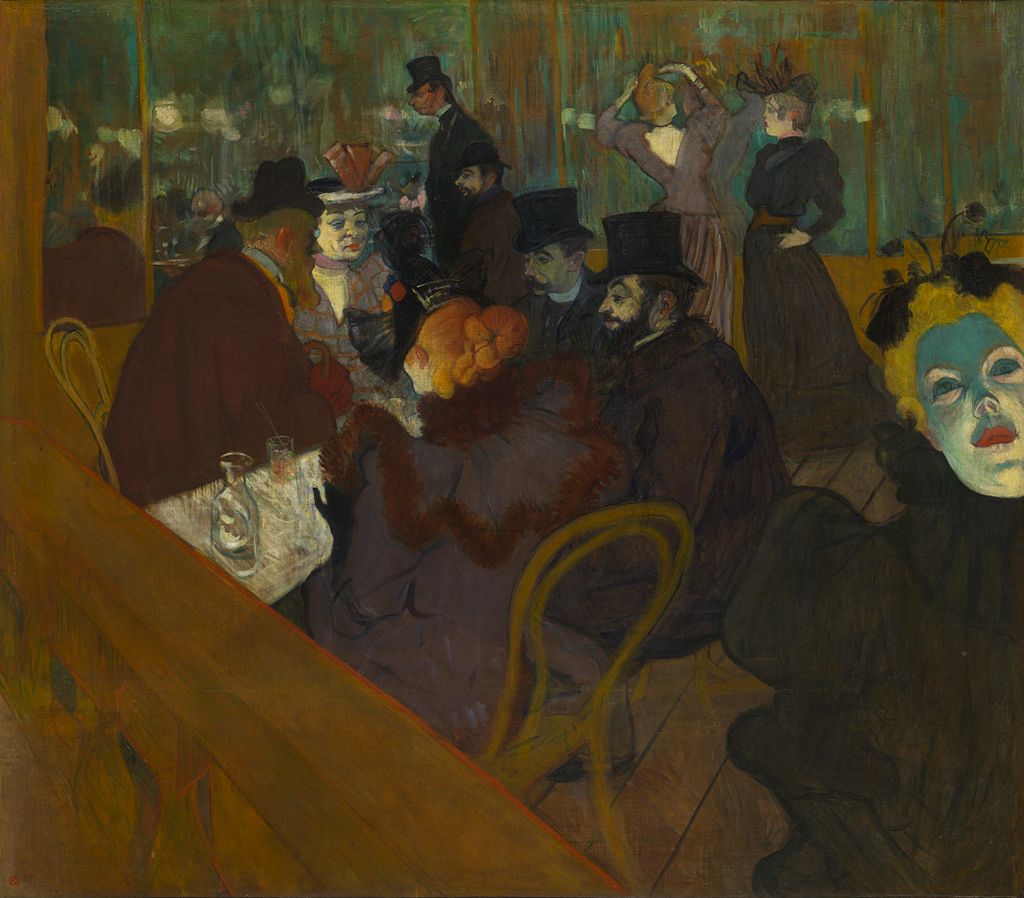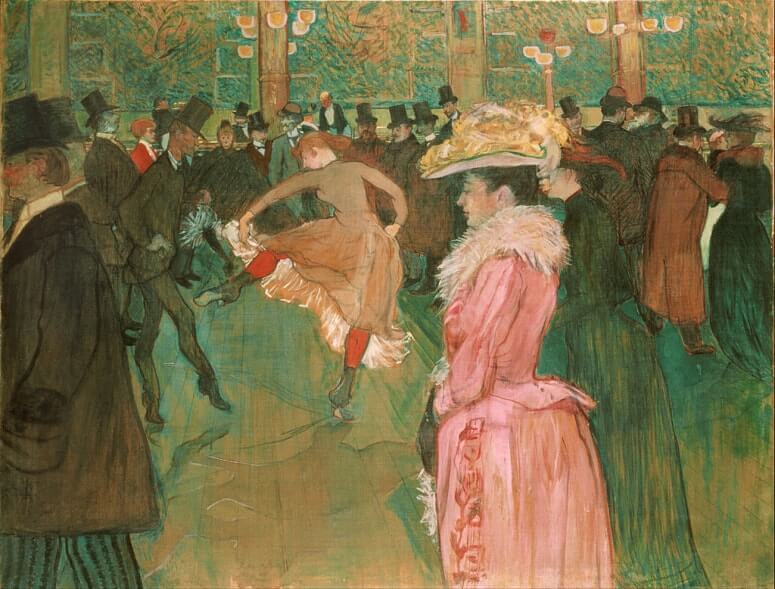|
Where? Gallery 243 of The Art Institute of Chicago
When? 1892-1895 What do you see? Behind a balustrade in one of the most popular nightclubs in Paris, three men and two women sit at a table, leaning into conversation. There are drinks on the table and each member of the party wears a fancy hat. The woman with orange hair is Jane Avril, a famous entertainer. Behind their table, one tall and one short man are passing by. In the right background, two women stand by a green mirror. The one fixing her hair is dancer La Goulue. Looking deeper into the room, there are many more guests sitting at tables with yellow lights hanging above them. Such a light may hang above the dancer May Milton in the left foreground. She stares at us with her bright teal skin, and her features have become grotesque and distorted under the harsh nightclub lights. Backstory: In the risky neighborhood of Montmartre, Paris, nightlife flourished through the end of the 19th century. People of various classes came to the nightclubs and dance halls in Montmartre to experience a social life unlike any other. In its heyday, the area was actually quite dangerous, but it has since been romanticized and sensationalized so that images and music associated with it evoke great nostalgia. Henri de Toulouse-Lautrec frequently visited the Moulin Rouge, a nightclub in the neighborhood. As such, he was very familiar with the other regulars. In At the Moulin Rouge, he was able to capture these characters on canvas and portray the true grunge of the Paris nightlife culture. Using bright colors and thick brush strokes, Toulouse-Lautrec paints in an Avant-Garde style, apt for his subject matter. What is the Moulin Rouge? Established in 1889, the Moulin Rouge was a cabaret and nightclub located in the Montmartre district of Paris. Featuring live performances from the stars of Paris, drinks, and room for socialization, the Moulin Rouge was a truly modern space. The iconic can-can dance was first performed at the Moulin Rouge, and, at the time, it was considered a very improper dance. Henri de Toulouse-Lautrec created several advertising posters for the Moulin Rouge, as well as several paintings of the Moulin Rouge. Among those paintings are At the Moulin Rouge: The Dance in the Philadelphia Museum of Art and La Goulue at the Moulin Rouge in the Museum of Modern Art.
Who is Toulouse-Lautrec? Henri Marie Raymond de Toulouse-Lautrec was born in Albi, France in 1864 to a wealthy family. As his mother and father were first cousins, Toulouse-Lautrec suffered from congenital health issues that affected his bones and growth. Due to these health issues, he became slightly isolated from society and spent his time making art. Painting in the Post-Impressionist style and printmaking in the Art Nouveau style, Toulouse-Lautrec captured the Bohemian lifestyle of 19th-century Paris. This was the lifestyle Toulouse-Lautrec immersed himself in Montmartre’s Moulin Rouge. He created a series of posters advertising the cabaret and displayed his artworks there.
Fun fact: The two men walking behind the table in the center of the painting are actually Henri de Toulouse-Lautrec himself and his cousin, Dr. Gabriel Tapié de Céleyran.
0 Comments
|
Categories
All
|
- Home
- Blog
-
Museums
- Alte Pinakothek
- Art Institute of Chicago
- Baltimore Museum of Art
- Barber Institute of Fine Arts
- Bargello
- Barnes Foundation
- British Museum
- Church of Sant’Anastasia
- Cleveland Museum of Art
- Courtauld Institute of Art
- Detroit Institute of Arts
- Frans Hals Museum
- Galleria Borghese
- Gallerie dell'Accademia
- Getty Museum
- Guggenheim
- Hermitage Museum
- Kunsthistorisches Museum
- Kunstmuseum Basel
- Legion of Honor Museum
- Louvre
- Mauritshuis
- Metropolitan Museum of Art
- Musee d’Orsay
- Museum of Fine Arts in Boston
- Museum of Modern Art
- National Gallery in London
- National Gallery of Art
- National Museum in Poznań
- Norton Simon Museum
- Ny Carlsberg Glyptotek
- Palace of Versailles
- Palazzo Pitti
- Palazzo Vecchio
- Petit Palais
- Philadelphia Museum of Art
- Prado
- Pushkin Museum
- Ravenna Art Museum
- Rijksmuseum
- San Diego Museum of Art
- Santa Maria delle Grazie
- St. Peter's Basilica
- Städel Museum
- Statens Museum for Kunst
- Tate Britain
- Tate Modern
- Timken Museum of Art
- Uffizi
- Vatican Museums
- Wallace Collection
-
Artists
- Altdorfer
- Anguissola
- Berlin Painter
- Bosch
- Botticelli
- Boucher
- Bronzino
- Bruegel the Elder
- Brunelleschi
- Cabanel
- Caillebotte
- Canova
- Caravaggio
- Carpeaux
- Cezanne
- Cimabue
- David
- Degas
- Delacroix
- De Maria
- Donatello
- El Greco
- Fontana
- Fra Angelico
- Fragonard
- Gauguin
- Gentileschi
- Gericault
- Gonzalez-Torres
- Goya
- Hals
- Hogarth
- Hokusai
- Ingres
- Leonardo da Vinci
- Lippi, Filippo
- Longhi, Barbara
- Lorrain
- Makovsky
- Manet
- Massys
- Matisse
- Merian
- Michelangelo
- Mochi
- Modigliani
- Monet
- Panini
- Parmigianino
- Perugino
- Picasso
- Pisanello
- Raphael
- Rembrandt
- Renoir
- Reynolds
- Rivera
- Rodin
- Rubens
- Scultori
- Seurat
- Steen
- Tintoretto
- Titian
- Toulouse-Lautrec
- Turner
- Uccello
- Van der Weyden
- Van Dyck
- Van Eyck
- Van Gogh
- Van Hemessen
- Vasari
- Velazquez
- Vermeer
- Veronese
- Vigée Le Brun
-
Locations
- Books
- About Us



